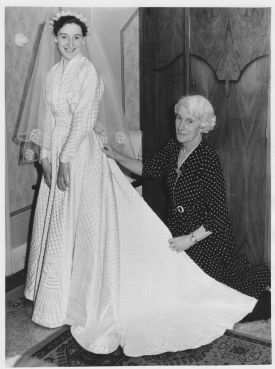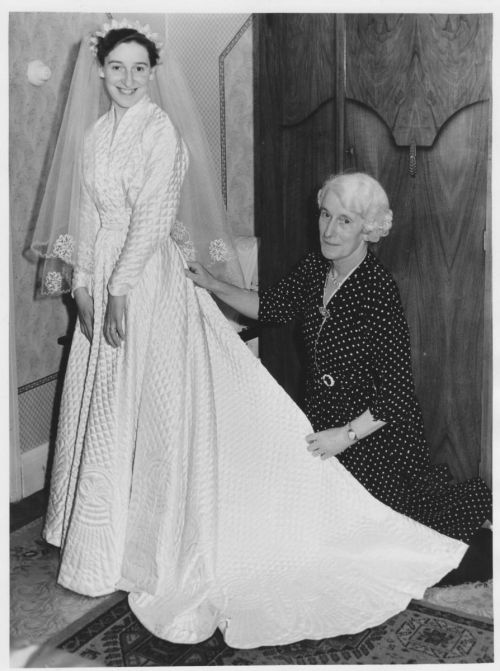Amy Emms MBE Interview by Dr. June Freeman, 1983
Published: Tuesday, 19th July 2011 16:35 PM

Amy Emms was an eminent quilter and an honorary member of the Patchwork and Quilting Guild. Born in 1904, in Fulwell near Sunderland, Emms played a key role in keeping the quilting traditions of the north East of England alive. Amy Emms practised and taught Durham, or North Country, quilting, the techniques of which had been handed down through generations of female relatives. She was taught to sew and quilt by her mother, who made quilts to sell to supplement the family’s income. In 1984, Amy Emms was awarded an M.B.E. for her outstanding contribution to the craft of quilting.
In August 1983, Amy Emms was interviewed by June Freeman. Extracts of this interview can be read below:
Celebrations:
June Freeman: So are there things you remember particularly fondly?
Amy Emms: When my daughter asked if I would quilt her wedding gown and would it be heavy. I said, ‘It won’t be heavy, Olive, and afterwards you could always make pram sets from it’, though they generally made evening gowns out of wedding gowns they’d dyed. So I set to and made it in white satin, cotton lined. When we got the skirt part finished, I says, ‘ well, Olive, it’s a circular quilt’. It was a nine yards circle. ‘And the bodice part could make a dressing jacket’. I haven’t done that because they’re thinking of putting it into some museum. On the wedding morning, the reporter from The Echo got to know about it. And then at night-time, when The Echo comes out, it was a good write up. After that, well, all the letters came about it. I’ve done dressing gowns and dressing jackets but that wedding gown stood out.
June Freeman: When you make quilts for other people, do they ever ask you to use particular patterns?
Amy Emms: No. I’m going to do a wedding quilt for Lady Hesketh’s daughter. I’ve just made Lord Hesketh a quilt, but Lady Hesketh wants another. I’ve got the material. It’s pure white silk. She just asked for a wedding quilt so it’ll have something on it, such as wedding bells and the lovers’ knots.
Sewing and War:
(World War One)
June Freeman: Did you learn to sew at school?
Amy Emms: No, I didn’t do much at school. It was during the First World War. I got very little schooling. I used to cut patches out and sew them to make dolly’s things . That’s how we started. I did a lot of knitting for the soldiers in the First World War: scarves and helmets, and mitts. We were young, mebbe seven, nine year old.
(World War Two)
June Freeman: You bought your first house during World War Two?
Amy Emms: Yes, during the Second World War. Then we were bombed out. Scarce anything left, everything ruined. Olive was living at home but our [son] George had been evacuated. Then we got a council house.
Women and the History of Quilting:
June Freeman: When your mother made a quilt in a week, how did she manage to do it so quickly?
Amy Emms: Well, she had to stay up all night. I’ve seen her quilting till two and three o’clock in the morning.
June Freeman: Did she sew by candle-light?
Amy Emms: Partly, and later by lamp light. I remember the paraffin lamp always on the table. That was a luxury.
June Freeman: How much did she get for making a quilt?
Amy Emms: Six shilling. But the club quilts, which she did in a week, she got a pound. Each member paid a pound and the club would go for twenty weeks. So that was twenty pounds in twenty weeks for her.
June Freeman: What did your mother feel about quilting? Did she enjoy it, or was it too much like hard work?
Amy Emms: Well she might enjoy it, but I think it was only for to get that little bit extra money. Sitting till two and three o’clock in the morning couldn’t be a pleasure, could it, rushing to get a thing done? You really shouldn’t have to worry when you’re quilting. You want to relax. The more you relax, the better. You don’t want to think, ‘Oh, I have me dinner to make’. You should take things easy and relax with it.
Durham/North Country Quilting:
Amy Emms: When I moved into the country, I thought, ‘Well, they’ll all know quilting’. My people belonged up where I am, you see, [Co. Durham]and of course they quilted and it was handed down mother to daughter, mother to daughter until it came to me. Now my daughter can do it, and so can the grand-daughter. They don’t do a lot. They wouldn’t take any in to do, but they’d do for themselves. Quilting was a dying craft in 1951.
June Freeman: Do you have names for patterns?
Amy Emms: Oh yes. Rose leaves, shells, fans. Then we have cable and feathers.
June Freeman: You say your mother used much bigger templates, but are they basically the same patterns?
Amy Emms: Same patterns but on a larger scale.
June Freeman: And do you ever make up new patterns?
Amy Emms: We’ve tried all kinds but they never work like the old ones.
Teaching:
June Freeman: You started showing at Sunderland in ’45, and you showed for eight years until ’53. When did you start your classes?
Amy Emms: 1951. The organiser sent for me because some of the craft teachers that helped to judge, thought they would have a class on quilting. We started the class with about 22 women. I’d never shown anybody before how to quilt but we had a good class. I was there sixteen year. In between time the daughter was married and her wedding gown caused us to get a lot of letters so we started another class on Wednesday afternoon.
June Freeman: Were you teaching before you took the diploma?
Amy Emms: Yes, I would have been nearly a year teaching. I was called to the office and they said if classes were to go on or fall through, I would be the one to be paid off because I had no diplomas. There was no City and Guilds for quilting. So, in 1951, I was sent to Durham. I’d never sat in a desk from 14 year old. Mrs Lough gave me some greaseproof paper and a pencil and a ruler and one pattern template, and she says, ‘Draw for a cushion’. I sat down with eight other women, all teachers of crafts, and I drew a pattern I thought was alright, and she came round and she says, ‘I can’t show you anything’. But anyway, I stayed. I had a lot of samples to do, such as a baby’s outfit, little coat, bootees and bib and bonnet, and a dressing case and a cushion. They were all judged at the end of the session of about twelve weeks, and I got my diploma without any bother. That meant I could teach.
Life and Quilting:
June Freeman: You left school at 14. What did you do then?
Amy Emms: I went for shorthand-typing. I went to an academy for business training. I became a clerk. I wanted to be all kinds of things. I wanted to be a waitress. I wanted to be a laundress. But a friend of mine went for shorthand-typing and I used to go and watch her do her homework, and I fancied it because I didn’t pass the exam to go to high school or secondary school.
June Freeman: Did you do any quilting while you were a clerk?
Amy Emms: Part-time.
June Freeman: When did you set up as a quilter?
Amy Emms: I joined the British Legion about 1941 or ‘43 and they used to have an exhibition in Sunderland Town Hall in June and I started showing quilts and cushions I’d done for other people and before I delivered them I put them in this exhibition. I won the quilting for 8 year. I couldn’t be beat. The other branches used to grumble at me getting the cup. So I packed it in to give somebody else a chance. I still have the replica quilting cup.
June Freeman: Can you remember when you got a machine?
Amy Emms: About three year after I married. I still have it and it’s over a hundred year old. I won’t have an electric one. I like my own machine.
June Freeman: Did you grow up sleeping under quilts yourself?
Amy Emms: Always. Sometimes we’d make what you call a hap, to put at the bottom. It would be done in pieces, not so fine as what you do in patchwork, biggish pieces, or, if my mother went to a remnant sale and got mebbe three yards of one colour and three of another, she would patch it to make stripes.
June Freeman: How important has quilting been to you?
Amy Emms: I wouldn’t be without it. it’s part of life to me. Since I lost my husband, it’s lifted me up. I don’t worry over it. It’s so relaxing I couldn’t do without quilting nowadays. And I look at all the friends I’ve met and I have fan-mail now through the quilting.
June Freeman: Does it give you a sense of achievement?
Amy Emms: Oh, yes, especially if you have a special quilt to do.
Further Reading
Emms, Amy (1990) Amy Emms’ Story of Durham Quilting. (Edited by Pam Dawson) Kent, Search Press Limited. Available in the Quilters’ Guild Library, reference: QM/EMM.
A book written by Amy Emms, which includes descriptions of her life and work, as well as instructions for working some of Emms’ designs.
Osler, Dorothy (2000) North Country Quilts: Legend and Living Tradition. Co. Durham, The Bowes Museum. Available in the Quilters’ Guild Library, reference: HUK/OSL.
Provides a good overview of the history and techniques of Durham/North Country Quilting, and includes a brief section on Amy Emms.
Osler, Dorothy (2004) ‘Amy Emms, M.B.E.: 1904-1998’. In: Merikay Waldvogel and Rosalind Webster Perry (editors) (2004) The Quilters Hall of Fame. Marion, Indiana, The Quilters Hall of Fame, Inc. pp 61-64. Available in the Quilters’ Guild Library, reference: QM/WAL.
This transcript was edited by Museum volunteer Victoria Griffin Boast
 Amy Emms with her daughter Olive Gregson. Image copyright Olive Gregson
Amy Emms with her daughter Olive Gregson. Image copyright Olive Gregson